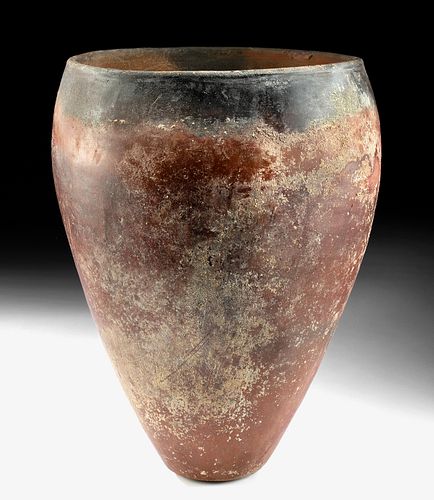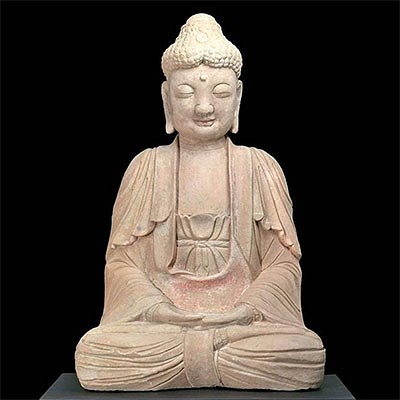Huge Egyptian Pre-Dynastic Naqada I Blacktop Jar
Lot 2a
About Seller
Artemis Fine Arts
686 S Taylor Ave, Ste 106
Louisville, CO 80027
United States
Selling antiquities, ancient and ethnographic art online since 1993, Artemis Gallery specializes in Classical Antiquities (Egyptian, Greek, Roman, Near Eastern), Asian, Pre-Columbian, African / Tribal / Oceanographic art. Our extensive inventory includes pottery, stone, metal, wood, glass and textil...Read more
Categories
Estimate:
$8,000 - $10,000
Absentee vs Live bid
Two ways to bid:
- Leave a max absentee bid and the platform will bid on your behalf up to your maximum bid during the live auction.
- Bid live during the auction and your bids will be submitted real-time to the auctioneer.
Bid Increments
| Price | Bid Increment |
|---|---|
| $0 | $25 |
| $300 | $50 |
| $1,000 | $100 |
| $2,000 | $250 |
| $5,000 | $500 |
| $10,000 | $1,000 |
| $20,000 | $2,500 |
| $50,000 | $5,000 |
| $100,000 | $10,000 |
| $200,000 | $20,000 |
About Auction
By Artemis Fine Arts
Feb 18, 2021
Set Reminder
2021-02-18 10:00:00
2021-02-18 10:00:00
America/New_York
Bidsquare
Bidsquare : Exceptional Antiquities, Asian, Ethnographic
https://www.bidsquare.com/auctions/artemis-gallery/exceptional-antiquities-asian-ethnographic-6373
Museum-worthy examples of Egyptian, Greek, Roman, Etruscan, Near Eastern, Far East / Asian, Pre-Columbian, African / Tribal, Oceanic, Native American, Spanish Colonial, Russian, Fossils, Ancient Jewelry, Fine Art, so much more! Artemis Fine Arts info@artemisfinearts.com
Museum-worthy examples of Egyptian, Greek, Roman, Etruscan, Near Eastern, Far East / Asian, Pre-Columbian, African / Tribal, Oceanic, Native American, Spanish Colonial, Russian, Fossils, Ancient Jewelry, Fine Art, so much more! Artemis Fine Arts info@artemisfinearts.com
- Lot Description
Ancient Egypt, Pre-Dynastic period, Naqada I, ca. 4000 to 3600 BCE. A wonderful coil-formed Nile silt pottery vessel with a lightly-burnished, russet-hued surface made with a thin iron-oxide slip. The vase has an ovoid body which tapers gently to a petite conical base, with a deep interior cavity and a gently rolled rim. The upper black-hued portion is comprised of thick carbon deposits formed by exposing the top to thick clouds of smoke for extended periods of time in an oxygen-deprived environment. Black-top vessels originally rose in popularity during the early Naqada I, a culture which inhabited ancient Egypt during its pre-dynastic period. The N`aqada were first described by famed archaeologist William Flinders Petrie; however, relatively little is known about them except that they were focused around the site of El-Amra in central Egypt, west of the Nile River. Size: 9.5" W x 14" H (24.1 cm x 35.6 cm)
Pre-Dynastic Egyptian black-top vessels were traditionally made from silt deposits taken from the Nile river due to their abundance in iron and silica. After the pot had dried but before it was fired, it would first be burnished and rubbed smooth with a small stone to create the pinstripe vertical striations still visible today. An iron-rich slip would then be applied just before firing; when placed in an oxygen-rich environment, the elevated temperatures would create the vessels’ signature red-orange hue.
After the end of the Naqada III period around 3,000 BCE, the use of Nile silt in pottery creations fell out of favor with the Pre-Dynastic Egyptians. This is due to the increase in popularity of marl clay, a newly-discovered material for creating terracotta objects which was easier to shape and enabled firing at far greater temperatures than the highly-porous silt.
A similar Naqada I example hammered for GBP 12,500 ($16,652.24) at Christie's, London, South Kensington Antiquities Auction (sale 7207, October 25, 2012, lot 31).
Provenance: ex-private Los Angeles, California, USA collection; ex-private London, UK collection; ex-private collection, acquired in the 1980s in the Netherlands
All items legal to buy/sell under U.S. Statute covering cultural patrimony Code 2600, CHAPTER 14, and are guaranteed to be as described or your money back.
A Certificate of Authenticity will accompany all winning bids.
We ship worldwide and handle all shipping in-house for your convenience.
#162595Repaired from two pieces with restoration over break lines. Two chips to rim, one of which is repaired. Expected surface wear commensurate with age. Otherwise, excellent with lovely mineral deposits throughout and impressive remaining pigments.Condition
- Shipping Info
-
All shipping is handled in-house for your convenience. Your invoice from Artemis Gallery will include shipping calculation instructions. If in doubt, please inquire BEFORE bidding for estimated shipping costs for individual items.
-
- Buyer's Premium



 EUR
EUR CAD
CAD AUD
AUD GBP
GBP MXN
MXN HKD
HKD CNY
CNY MYR
MYR SEK
SEK SGD
SGD CHF
CHF THB
THB
















